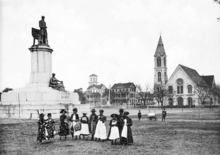John C. Calhoun Monument
| John C. Calhoun Monument | |
|---|---|
 The monumnet in 2006 | |
| Year | 1887 |
| Subject | John C. Calhoun |
| Dimensions | 35 m (115 ft) |
| Condition | removed |
| Location | Charleston, South Carolina, United States |
The John C. Calhoun Monument was a monumental statue in Charleston, South Carolina, United States. The monument was 115 feet tall, and stood at the center of Marion Square in Downtown Charleston. It depicted John C. Calhoun, a prominent American statesman and politician from Abbeville, South Carolina who served as Vice President of the United States from 1825 to 1832 and who was an adamant supporter of American slavery.
The monument had long been surrounded by controversy, and was ultimately removed in June 2020.
History[edit]
Soon after John C. Calhoun's death in 1850, the Ladies' Calhoun Monument Association (LCMA) was formed "to aid in the erection, in or near the City of Charleston, of a monument sacred to the memory of John C. Calhoun."[1] However, the campaign initially struggled with fundraising, facing issues including embezzlement and lack of preparedness.[2] The association held several donor meetings and depended heavily on wealthy Charlestonian philanthropists to reach the appropriate amount.
The monument was finally built 27 years later, in April 1887.[3] Parades and celebrations were hosted across the city, and the LCMA helped unveil the statue to those in attendance. The LCMA described the unveiling ceremony's attendance as "crowded to [Marion Square's] boarders with such an assemblage as is rarely seen anywhere."[1] Soon after the unveiling, prayers and joys were shouted for protection over the newly erected monument.[1]

Many historians have argued that the purpose of the statue was to venerate slavery and the Antebellum South, and to intimidate and marginalize black Charlestonians.[3] According to Mamie Garvin Fields, born in 1888, she later stated, "I believe white people were talking to us about Jim Crow through that statue."[3] Several other black Charlestonians felt that the statue was a threatening message to them: that even though Calhoun was dead, his spirit still lingered in the streets Charleston, South Carolina.[3] Freedmen and women of Charleston began to damage the statue in protest; soon the statue barely resembled Calhoun.

This led the LCMA to pursue the installation of a new, taller version of the monument to protect it from further vandalism. The new version of the statue was dedicated by the LCMA on June 27, 1896 with little fanfare. According the LCMA, the statue cost nearly $20,000 (roughly $500,000 in 2020 dollars).[4] The individual who completed the 1896 monument was an Irish-born contractor, Daniel A. J. Sullivan, who is listed as a carpenter by trade and eventually became a prominent builder in Charleston after the American Civil War. Sullivan was noticeably active in the local Democratic Party and later served in the state legislature.[5]
Controversy and Removal[edit]


Over time, the statue became controversial for Calhoun's staunchly pro-slavery views, especially in the aftermath of the 2015 shooting at the nearby Emanuel African Methodist Episcopal Church. [6] In 2017, a committee was formed to consider how citizens could interpret the statue. The committee was tasked to create a plaque putting the state in greater historical context. The verbiage of the plaque was never agreed upon, and the committee was disbanded.[7]
In the wake of the murder of George Floyd in the summer of 2020, there were calls across the United States to remove monuments and statues connected with the lost cause myth or individuals who supported slavery. Many such statues were defaced or protested, including the Calhoun monument. On June 23, 2020, the statue was taken down after a unanimous vote by the Charleston City Council.[8] The current location of the John C. Calhoun bust is undisclosed. Some groups have called for the statue to be placed inside a museum. However, the Charleston Museum declined the city's request. As of October 2020, the statue has still not been claimed by any museum or historical society.[3]
See also[edit]
References[edit]
- ^ a b c Ladies' Calhoun Monument Association (1888). A History of the Calhoun Monument at Charleston, S. C. Lucas, Richardson, printers.
- ^ Smith, Fleming (22 June 2020). "Charleston's Calhoun monument: How a little-known 1850s relative stole its funds". Post and Courier. Retrieved 2020-10-07.
- ^ a b c d e Roberts, Blain; Kytle, Ethan J. (2012). "Looking the Thing in the Face: Slavery, Race, and the Commemorative Landscape in Charleston, South Carolina, 1865–2010". The Journal of Southern History. 78 (3): 639–684. ISSN 0022-4642. JSTOR 23247373.
- ^ Brown, Angela (2020-06-23). "Looking back at controversial history of Calhoun monument". WCIV. Retrieved 2020-10-10.
- ^ "Charleston's deposed Calhoun monument and the erasure of Black workers". Facing South. 2020-06-26. Retrieved 2020-10-10.
- ^ Ellis, Rachel (2020-06-22). "Two groups gather around John C. Calhoun statue to debate fate of monument". WCIV. Retrieved 2020-10-12.
- ^ Darlington, Abigail (November 2017). "Charleston committee to consider new Calhoun statue plaque: 'relic of the crime against humanity'". Post and Courier. Retrieved 2020-10-07.
- ^ Hobbs, Stephen (23 June 2020). "John C. Calhoun statue taken down from its perch above Charleston's Marion Square". Post and Courier. Retrieved 2020-10-07.
- Buildings and structures in Charleston, South Carolina
- John C. Calhoun
- Monuments and memorials in South Carolina
- Monuments and memorials in the United States removed during the George Floyd protests
- Outdoor sculptures in South Carolina
- Sculptures of men in South Carolina
- Statues in South Carolina
- Statues removed in 2020
- Vandalized works of art in South Carolina
